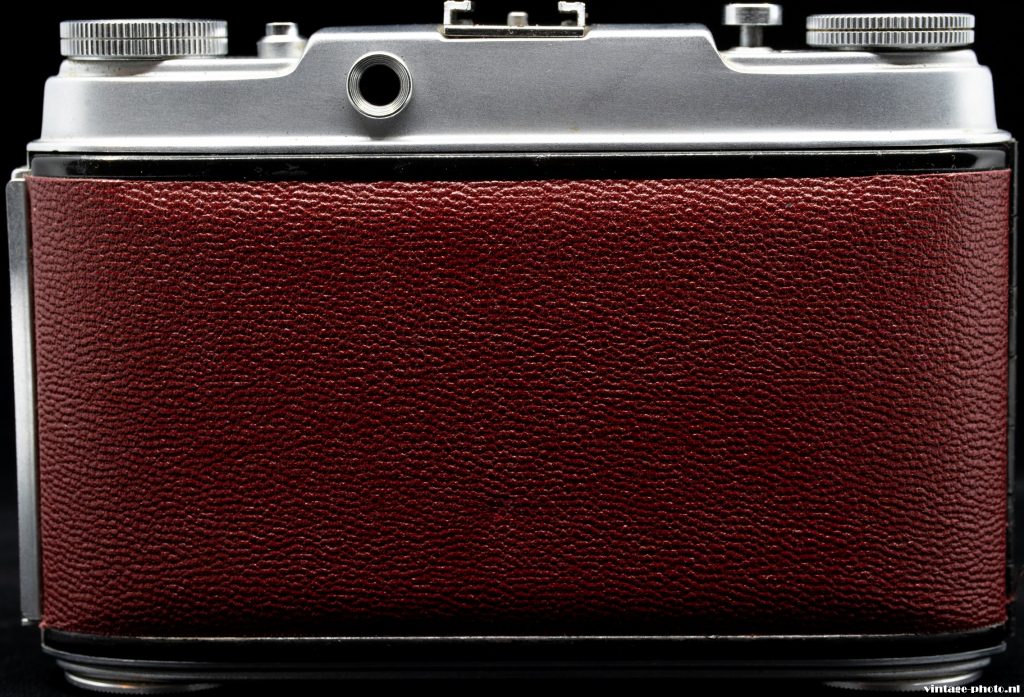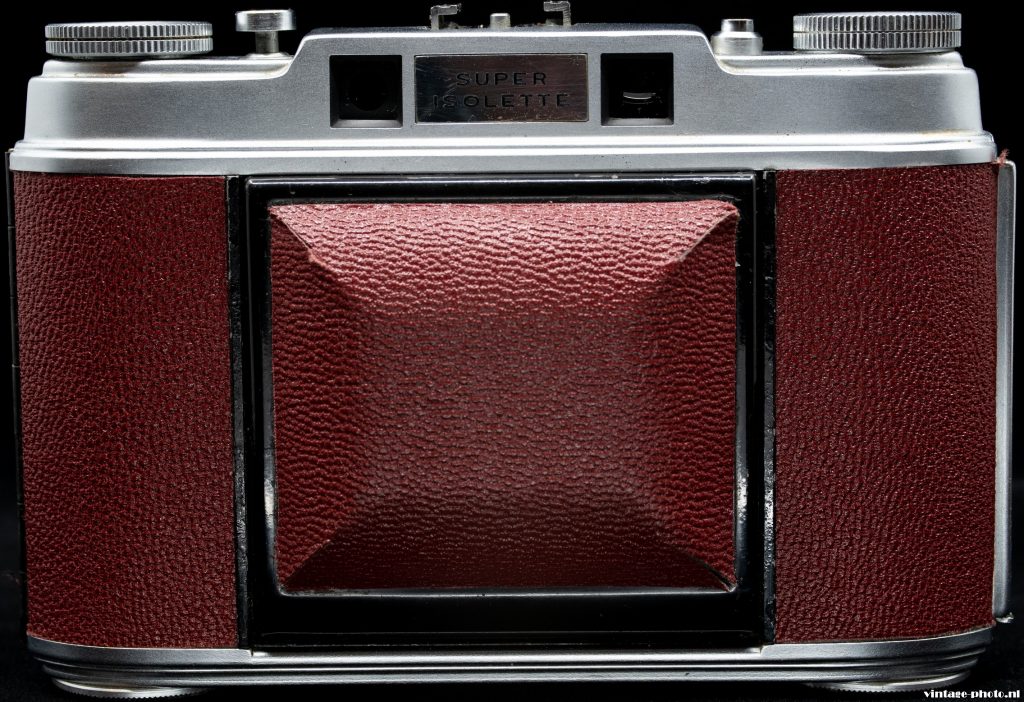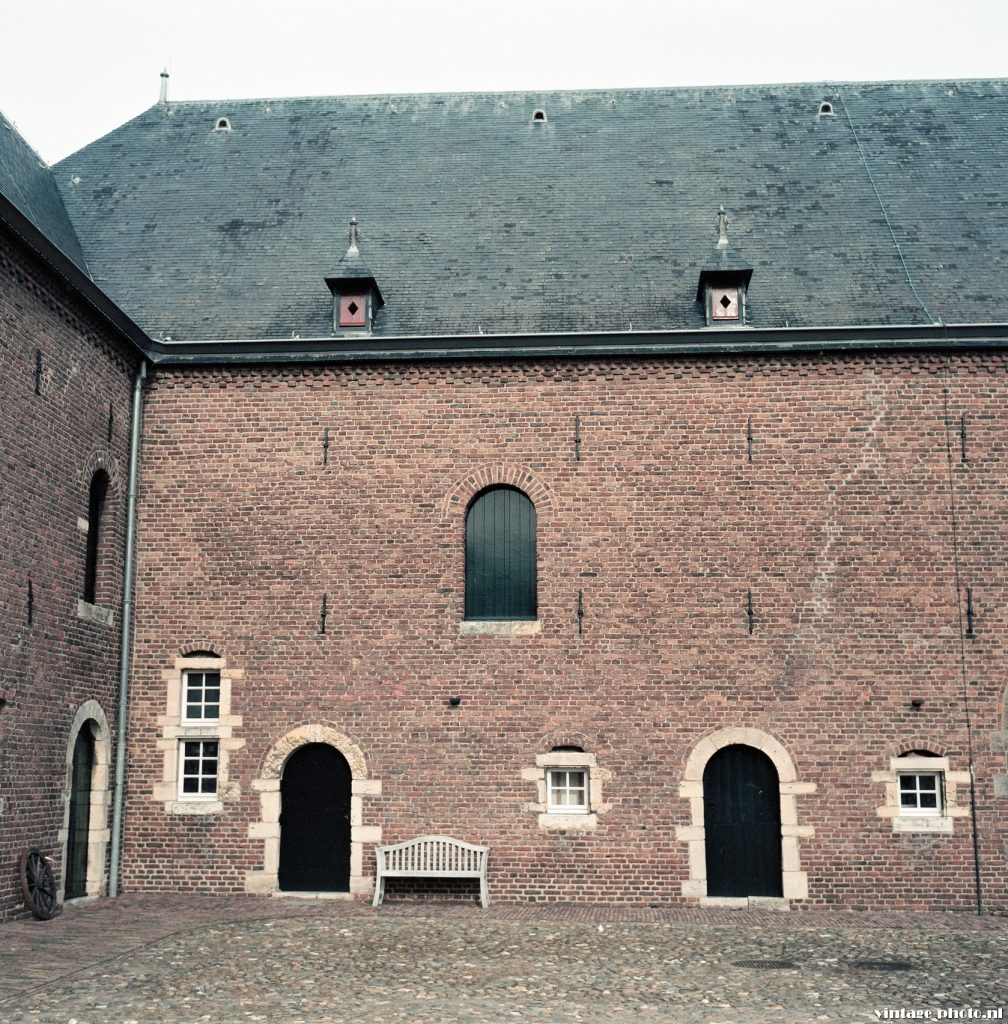There is always much debate as to what makes a camera the best in its class. In the case of the Agfa Super Isolette, made in Berlin, the unanimous opinion is that it is the best medium format folder ever made. A camera that has aroused much envy from Leica and Zeiss Ikon. Yet the success of the camera came decades after its first production in 1954. The rapid decline in sales of 120 film in favor of the many times more popular 135 film and growing market for 35mm cameras was to blame. Not many Super Isolettes have come on the market, which complicates the search for this top Agfa model.
The wine red leathered Super Isolette immediately made my heart beat faster. The previous owner had it overhauled by Jurgen Kreckel, a phenomenon when it comes to CLAs of folder cameras. Loosening it from the light brown leather ready bag the sexiest camera I’ve ever seen comes into my hands. Complete new red bellows, new applied red leatherette around the body. A creative variation on all that stuffy black that characterizes folder cameras so much. It gets even better. In my hands lays a technical ingenuity, a thoughtful top-of-the-line camera from Agfa, a coupled rangefinder in medium format. And that’s pretty unique. Of course there are the Zeiss Super Ikontas, but they are a lot bigger and look old-fashioned, compared to this shiny, lighter and still reasonably compact camera.
The Isolette is one of the most well-known Agfa productions. Originally named Isorette in 1937, it was soon renamed. It is a long running series of cameras, with varying number designations, first 4.5, then 5 and than again III, I, II and L. Some models as only viewfinder models, others with an uncoupled rangefinder. Usually they came as a 6×6 or 6×4.5 version. To make things even more confusing, Agfa also had a successful 35mm camera under the name Silette. It is noteworthy that Agfa only produced cameras to increase the sales of its own Agfa films. It was actually not about being the best, but the best-selling film supplier. Yet the camera division was very popular and the cameras consequently loved by the public. They are distinguished by a fresher and more modern appearance, compact, easy to use. At the same time, Agfa also made some sacrifices in terms of quality. Common problems with the shutters and especially the biggest weakness: the bellows that only remained light-tight to a limited time and quickly showed holes, especially if they were not made of leather.
The Super Isolette was to become the showpiece of Agfa’s medium format series. A top of the line rangefinder with an unsurpassed quality lens and a unique film transport. All or nothing. It became all. Agfa had already succeeded in putting the Solinar f/3.5 75 mm, equipped with four lenses in 3 groups on its Isolettes I and II. A hit, as the lens produced ‘Tessar’ quality, perhaps even better. Especially the remarkable sharpness (even with the aperture wide open) is the biggest plus, because focussing is not done by rotating the lens, but the lens as a whole moves from back to front. The film transport is the most innovative you can find on a folder. Instead of a red peephole for tracking film numbers, in the Super Isolette a unique pointy metal gear that penetrates the film and takes care of measuring, winding and exact positioning all 12 of the 6×6 frames.
The shutter is a Synchro Compur leaf shutter. Probably the best shutter ever made. It is one of the most common and reliable shutters, even after decades of not being used they easily come back to life. The shutter is located in the lens and sometimes they are easy to reach and open and lubricate (gently with lighter fluid) or clean the parts with a cotton swab. As is often the case with these old cameras, slow shutter speeds are more prominently represented. So also on the Agfa they run from 1, 2, 5, 10, 25, 50, 100, 250 and 500/s plus Bulb. Should you need faster times, e.g. to use large apertures in bright light, ND filters offer a solution. The filter size on the Solinar is 29.5 mm (or 32mm push on) and for this thread there are adapter rings 29,5-37 mm available for which than a whole range of filters become available. Same goes for a sunhood, although a vintage 32 mm ‘push on’ hood looks better.
The lens is coated and has 10 aperture blades. Although the lens displays F22 as the smallest aperture, the lens can be stopped down further to about F42. Furthermore, the shutter is fully synchronized for flash, all times can be used, both in M (for flash lights) or X (electronic flash) mode. Furthermore, the shutter is fully synchronized for flash, all times can be used, either in M (for flash) or X (electronic flash) mode. The flash is connected via the PC-sync connection on the lens for which the cables are still easily available. There is also the shutter delay in the so-called V(erzoegerungs) mode of about 8 seconds. Plenty of time to include yourself in the picture. Focusing is very precise through the viewfinder glass. In the center is a small round patch for the rangefinder that contrasts well even at long distances. In addition, the lens moves from back to front, which benefits the sharpness. The shutter button on the body is connected to the shutter on the lens. There is a lock system that prevents double exposures. Also, the shutter does not work when there is no film in the camera.
Inserting a film is done gallantly, no other camera has helicoid spool holders that open and close very precisely to take the film in and out. The metal film bearings and pressure plate on the back cover ensure that the film runs flatly and precisely from left to right. In the left button on the top plate reminder letters can be set for R for reversal (slides) and N for negatives (prints). The D is for daylight, and T for tungsten (indoor) color film. On the right, the frame numbers can be seen. The wind button stops automatically at each succeeding number. The known red dots on the lens dials are meant for quick pictures, so f/9.5 is for people without exposure meters and the dots at the distance scale are markers for sharp photos at either short or long distances. It’s a pity that the Super Islotte doesn’t have its own exposure meter; that didn’t come until 1956 with the Agfa Automatic 66. But there are several ways to measure the light via pluggable light meters on the coldshoe (even small, cheap digital ones), (vintage) handheld meters (like my beloved Zeiss Ikon Ikophot) or just applying the Sunny Sixteen rule or use a phone app.
The Agfa Super Isolette is one of the few 6×6 coupled rangefinder folders. As far as I know, there is only the Certo6 and the Zeiss Ikon Super Ikonta. The Agfa Super Isolette is one of the few 6×6 coupled rangefinder folders. Known only are the Certo6 and the Zeiss Ikon Super Ikontas (like the 530 and 532) and a few inexpensive brands. The Agfa is head and shoulders above them all. Not only because of its fabulous lens quality, but also its film transport, ease of use and full metal finish. The Agfa is a pleasure to use, but that pleasure comes at a high price. To this must be added the cost of thorough maintenance. Is it worth it? It is if you want to drive the Mercedes among the medium format folders.

Agfa super Isolette 
Agfa super Isolette 
Agfa super Isolette 
Agfa super Isolette 
Agfa super Isolette 
Agfa super Isolette 
Agfa super Isolette 
Agfa super Isolette 
Agfa super Isolette























This write up covers a lot of ground. For example, most reviewers don’t know that the filter threads are 29.5mm. Well done.
I could go on and on about the quality of the Agfa Super Isolette, but I’ll finish by saying that by using this gem of a 6×6 camera, I decide to sell my Rolleiflex TLR camera. The images from the unit focusing 75mm Solinar are that good. Plus, the folding klappkamera design was much better suited for travel.
Thanks Andrew, I agree it is the-one-to-have as it will outperform most of the folders and even TLR’s of that time. Soon I ll review the similar Super Ikonta B 532/16, it seems it is a close match to the Agfa.
I too have an Agfa Super Isolette and agree its just as good if not better than a Rolleiflex.Its certainly more compact easily slipping into a small over the shoulder bag.Prints from it are fantastic, the Solinar lens give that classic 50s look to images that I like so much.I got mine from the well known folder specialist Certo 6 a few years ago.Its a keeper
Thank you for the great review, I enjoyed it. I love my Super Isolette and am using it almost exclusively right now. It is a terrific travel camera and has been overseas with me several times, most recently to Chile. I also own a couple Twin Lens Reflex cameras (Rolleiflex, Ikoflex, etc.) but this camera gets the majority of the use because the image quality is so good. Interestingly I also bought mine from Jurgen (Certo6) many years ago when E-Bay was a bit easier to use. He gave it a full overhaul and, except for one hiccup which Jurgen quickly repaired, it has worked reliably for over ten years.
Thank you for your review. I like its depth and detail. I too have a Super Isolette since 1983. It needs servicing, I liken it to running a classic viercle. Its lens is better than the Tessar on my Rolleiflex and being a folder it comes to more palces with me. I like the Agfa Solinar lens a lot I have this one and a 45mm 2.8 on a 35mm Agfa camera, bot lenses produce creamy smooth micro contrast and beautifully rensered detail, and work well wide open. I have just taken it on holiday, exposed some films and enjoyed using it as much as anything else. It has never given me any trouble in 40 years.
Thanks for the nice article. I have just bought my third Super Isolette from ebay. Always regretted selling the others. They compare favorably with Tessar based Rolleis and Ikoflexes. And are a lot more portable. The main drawbacks are the small viewfinder and a lack of a light meter. They are better picture takers than any Super Ikonta. Although a late model 532/16 or 533/16 with the radioactive lens elements (look for the yellow front element and serial number over a million) comes close. Long live film. Regards, Mark.
Could anyone clarify if this camera should have any light seal material around the film door recesses on the camera body. Mine seems only to have 1 felt strip at the door hindge.
Many thanks in advance